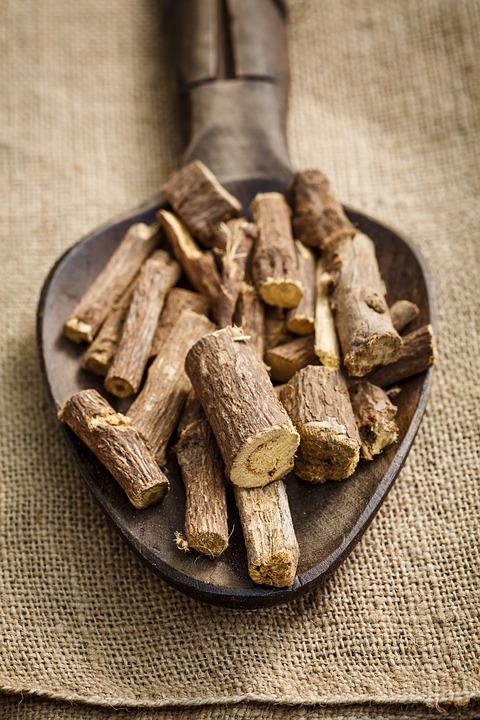

| Biological Name: Glycyzrrhiza glabraLeguminosae, Papilionaceae | ||||||||||||||
| Other Names: Licorice, Yashtimadhu, Mithi-lakdi, Mulathi, Liquorice, sweetwood, licorice rootAtimadhuram, Erattimadhuram, Liquorice | ||||||||||||||
| Description:This herb is found in many countries. It is believed to give contentment and harmony. | ||||||||||||||
| Parts Used: Dried root | ||||||||||||||
Active Compounds:
|
||||||||||||||
| History:Licorice is a traditional herbal remedy with an ancient history and world wide usage. Modern research has shown it to have effects upon, amongst other organs, the endocrine system and liver. The triterpenes of Glycyrrhiza are metabolized in the body to molecules that have a similar structure to the adrenal cortex hormones. This is possibly the basis of the herbs anti-inflammatory action. | ||||||||||||||
| Medicinal ApplicationsAction
anti-inflammatory, anti-hepatotoxic, anti-spasmodic, demulcent, emetic, expectorant, laxative, rejuvenative, sedative, tonic. Uses abdominal pain As an anti-hepatotoxic licorice is effective in the treatment of chronic hepatitis and cirrhosis, for which it is been widely used in Japan. Much of the liver orientated research has focused upon the triterpene glycyrrhizin. This inhibits hepatocyte injury caused by carbon tetrachloride, benzene hexachloride and PCB. Antibody production is enhanced by glycyrrhizin, possibly through the production of interleukin. Glycyrrhizin inhibits the growth of several DNA and RNA viruses, inactivating Herpes simplex virus particles irreversibly. It has a variety of uses in bronchial problems such as catarrh, bronchitis and coughs in general. Liquorice is used in allopathic medicine as a treatment for peptic ulceration, a similar use to its herbal use in gastritis and ulcers. It can be used in the relief of abdominal colic. It nourishes the brain-increasing cranial and cerebrospinal fluid. Also improves complexion, hair, and vision. |
||||||||||||||
| Dosage:Decoction, milk decoction, powder, ghee
Decoction: put 1/2 – 1 teaspoonful of the root in a cup of water, bring to the boil and simmer for 10-15 minutes. This should be drunk three times a day. Tincture: take 1-3ml of the tincture three times a day. |
||||||||||||||
| Safety:Caution : There is a small possibility of effecting electrolyte balance with extended use of large doses of licorice. It has an ACTH like effect causing retention of sodium thus raising BP. The whole herb has constituents that counter this but it is best to avoid Licorice if the patient has hypertension, kidney disease or during pregnancy.
It may interfere with the calcium and potassium absorption. Do not use if you are suffering from osteoporosis, hypertension (increases water around heart). Take with boiled milk. No other information about the safety of this herb is available. Use caution. Ayurvedic herbs are often taken in combination with others to neutralize the toxicity one herb with the opposing effect of other. Do not take except under the supervision of a qualified professional. |
